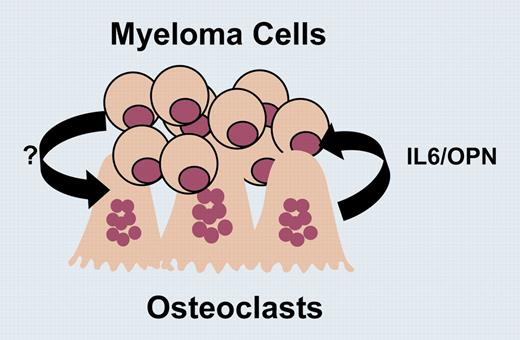Comment on Abe et al, page 2484
This article demonstrates the importance of osteoclast–myeloma cell interactions in both tumor growth and the bone destructive process in myeloma.
In this issue, Abe and colleagues demonstrate that osteoclasts (OCs) support the growth of myeloma cells and that adhesive interactions between myeloma cells and OCs increase both the proliferation of myeloma cells and promote the survival of OCs. They further show that interleukin-6 (IL-6) and osteopontin (OPN), produced by OCs when they bind myeloma cells, are responsible for the enhanced growth of myeloma cells (Figure 1). However, in the presence of these adhesive interactions, blocking IL-6 and OPN with neutralizing antibodies only partially abrogates the growth-enhancing effects of OCs on myeloma cells, demonstrating the importance of these adhesive interactions. The authors further report that OCs support the growth of myeloma cells to a much greater extent than marrow stromal cells, even when additional OPN and IL-6 are added to the marrow stromal cells. Finally, they demonstrate that adhesive interactions between OCs and myeloma cells protect myeloma cells from the cytotoxic effects of doxorubicin.
These studies further support the important role of the bone marrow microenvironment in the development of bone lesions and tumor growth in myeloma. Yaccoby and coworkers1 have shown that blocking osteoclastic bone resorption with bisphosphonates or osteoprotegerin results in decreased growth of myeloma cells. Recently, they have also reported that OCs support the growth of primary myeloma cells.2 Furthermore, the interplay between OCs, marrow stromal cells, and tumor cells results in a “vicious cycle” that increases both bone destruction and tumor growth. The finding by Abe et al that OCs appear to better support myeloma cell growth than the stromal cells may reflect the difference in the capacity of these cells to produce OPN. The fact that αvβ3 integrin is involved in these interactions is not surprising sinceαvβ3 is expressed on OCs and binds OPN. The binding of myeloma cells to OCs results in enhanced OC production of OPN, which may in part explain the increased OC survival in these studies. Loss of cell adhesion decreases OC survival.3 FIG1
Adhesive interactions via α4β1 integrin induce production of IL-6 and OPN by osteoclasts, which increase the growth and chemoresistance of myeloma cells. In addition, these interactions enhance osteoclast survival.
Adhesive interactions via α4β1 integrin induce production of IL-6 and OPN by osteoclasts, which increase the growth and chemoresistance of myeloma cells. In addition, these interactions enhance osteoclast survival.
IL-6 has also been implicated as a mediator for marrow stromal cells as it supports the growth and survival of myeloma cells, and Nefedova and coworkers4 have previously reported that adhesive interactions between myeloma cells and marrow stromal cells make myeloma cells resistant to chemotherapeutic agents. This paper extends these previous findings of the important role the marrow microenvironment plays in myeloma and identifies the OC as a major player in the growth of myeloma cells. Mori et al5 have recently shown that interrupting adhesive interactions between myeloma cells and marrow stromal cells in a murine model of myeloma decreases tumor growth and bone destruction and may be an important therapeutic target for treating patients who have chemoresistant disease. ▪


